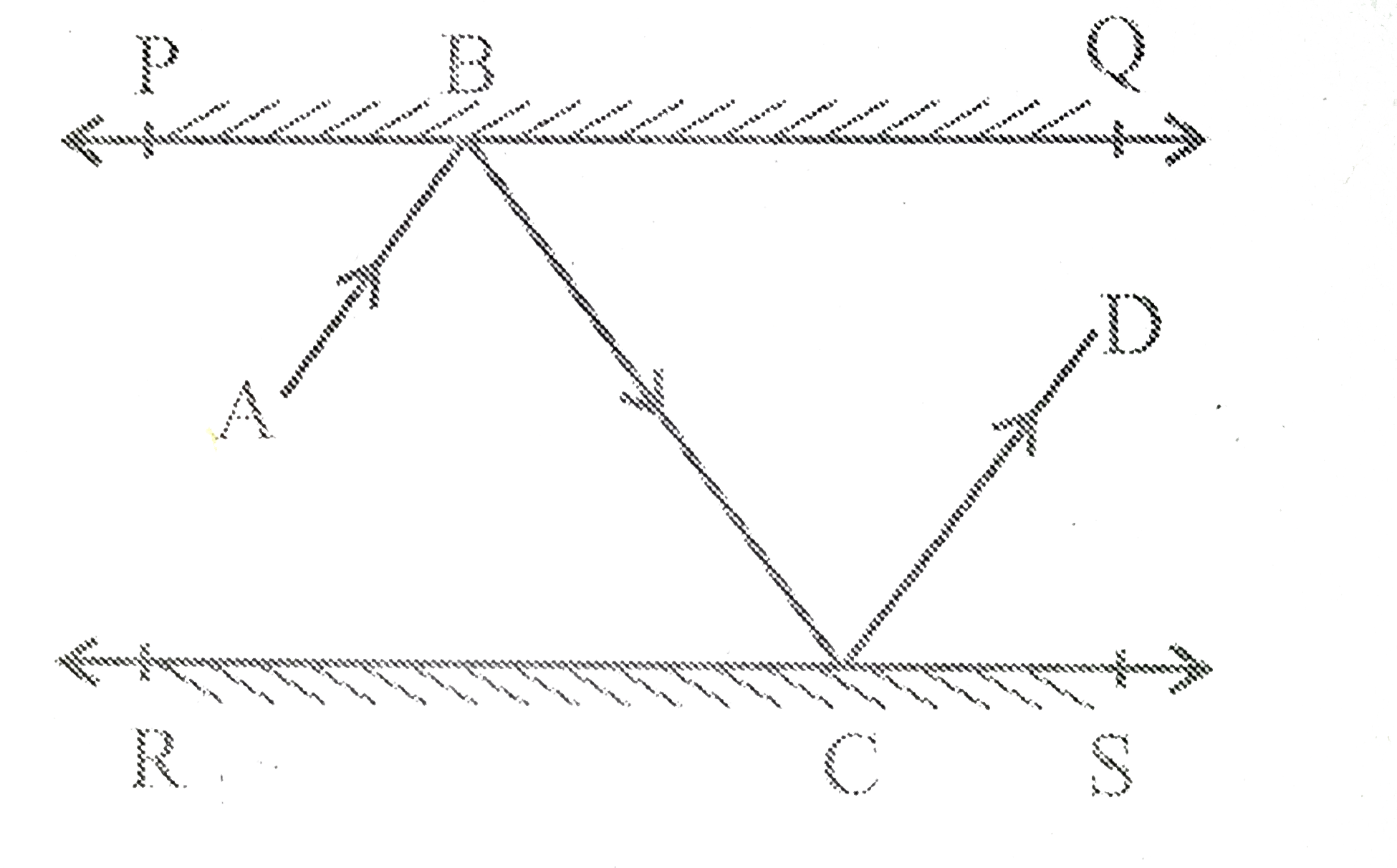PQ type incident radiation and RS is the reflected ray. They are both parallel. So which mirror on the right makes this possible? There may be one or more reflections through the mirror.
 Solution in Gujrati
Solution in Gujrati
Plane mirror
Convex mirror
Plane and concave mirror
An concave mirror
The correct Answer is:A, C, D

PQ and RS rays parallel to a given concave mirror.
Topper's Solved these Questions
- BOOK - KUMAR PRAKASHANCHAPTER - RAY OPTICS AND OPTICAL INSTRUMENTSEXERCISE - SECTION-D (MULTIPLE CHOICE QUESTIONS (MCQs))(MCQs FROM .DARPAN. BASED ON TEXTBOOK)(REFRACTION)32videos
RAY OPTICS AND OPTICAL INSTRUMENTS
- BOOK - KUMAR PRAKASHANCHAPTER - RAY OPTICS AND OPTICAL INSTRUMENTSEXERCISE - SECTION-D (MULTIPLE CHOICE QUESTIONS (MCQs))(MCQs FROM .DARPAN. BASED ON TEXTBOOK)(TOTAL INTERNAL REFLECTION)14videos
RAY OPTICS AND OPTICAL INSTRUMENTS
- BOOK - KUMAR PRAKASHANCHAPTER - RAY OPTICS AND OPTICAL INSTRUMENTSEXERCISE - SECTION-C (NCERT EXEMPLAR SOLUTION) (LONG ANSWER TYPE QUESITONS)5videos
RAY OPTICS AND OPTICAL INSTRUMENTS
- BOOK - KUMAR PRAKASHANCHAPTER - MOVING CHARGES AND MAGNETISMEXERCISE - SECTION D (MCQs ASKED IN COMPETITIVE EXAMS)34videos
MOVING CHARGES AND MAGNETISM
- BOOK - KUMAR PRAKASHANCHAPTER - SAMPLE QUESTION PAPER EXERCISE - PART-B SECTION-C5videos
SAMPLE QUESTION PAPER
Similar Questions
Refraction index of medium-2 with respect to medium-1 is ...... .
04:34View SolutionWhen light ray travels from ...... then total internal reflection is possible.
03:57View SolutionShow that for a material with refractive index μ≥√2~ , light incident at any angle shall be guided along a length perpendicular to the incident face.
01:46View SolutionElectric charge Q having mass M moves on a circular path of radius R with velocity →v, perpendicular to uniform magnetic field B. When a particle completes one revolution, work done by the field is _______
04:36View SolutionTwo charges –q and +q are located at points (0, 0, –a) and (0, 0, a), respectively.
(a) What is the electrostatic potential at the points (0, 0, z) and (x, y, 0) ?
(b) Obtain the dependence of potential on the distance r of a point from the origin when r/a>>1 .
(c) How much work is done in moving a small test charge from the point (5,0,0) to (–7,0,0) along the x-axis? Does the answer change if the path of the test charge between the same points is not along the x-axis?04:03View SolutionIn Fig. 6.33, PQ and RS are two mirrors placed parallel to each other. An incident ray AB strikes the mirror PQ at B, the reflected ray moves along the path BC and strikes the mirror RS at C and again reflects back along CD. Prove that AB || CD.
 02:58View Solution
02:58View SolutionIn Figure, PQ and RS are two mirrors placed parallel to each other. An incident ray AB strikes the mirror PQ at B, the reflected ray moves along the path BC and strikes the mirror RS and C and again reflects back along CD. Prove that AB∣∣CD.
 02:17View Solution
02:17View SolutionThe plane of a mirror makes an angle of 30º with horizontal. If a vertical ray is incident on a mirror, then what is the angle between mirror and reflected ray ?
07:28View Solutionआकृति 6.33 में PQ और RS दो दर्पण है जो एक दूसरे के समांतर रखे गए है । एक आपतन किरण (incident ray) AB, दर्पण PQ से B पर टकराती है और परिवर्तित किरण (reflected ray) पथ BC पर चलकर दर्पण RS से C पर टकराती है तथा पुनः CD के अनुदिश परावर्तित हो जाती है । सिद्ध कीजिये की AB∣∣CD है ।
 05:07View Solution
05:07View Solutionआकृति 6.33 में PQ और RS दो दर्पण है जो एक दूसरे के समांतर रखे गए है । एक आपतन किरण (incident ray) AB, दर्पण PQ से B पर टकराती है और परिवर्तित किरण (reflected ray) पथ BC पर चलकर दर्पण RS से C पर टकराती है तथा पुनः CD के अनुदिश परावर्तित हो जाती है । सिद्ध कीजिये की AB∣∣CD है ।
 07:27View Solution
07:27View Solutionसमान्तर आपतित किरणों के परावर्तन के आरेख बनाकर स्पष्ट कीजिये की किस प्रकार का दर्पण अभिसारी होता हैं तथा किस प्रकार का दर्पण अपसारी|
01:23View SolutionIf a light ray is incident on a horizontal plane mirror making an angle 30^(@) with the mirror, what angle will the reflected ray make with the mirror ?
01:48View SolutionIn the given Figure , PQ and RS are two mirrors placed parallel to each other . An incident ray AB striker the mirror PQ at B, the reflected ray moves along the path BC and strikes the mirror RS at C and again reflects back along CD. Prove that AB∣∣CD.
 04:08View Solution
04:08View SolutionIn the adjacent figure PQ and RS are two mirrors placed parallel to each other. An incident ray AB strikes the mirror PQ at B, the reflected ray moves along the path BC and strikes the mirror RS at C and again reflected back along CD . Prove that AB || CD.
 02:55View Solution
02:55View SolutionIn the adjacent figure PQ and RS are two mirrors placed parallel to each other. An incident ray AB strikes the mirror PQ at B, the reflected ray moves along the path BC and strikes the mirror RS at C and again reflected back along CD . Prove that AB || CD.
 03:24View Solution
03:24View Solution
